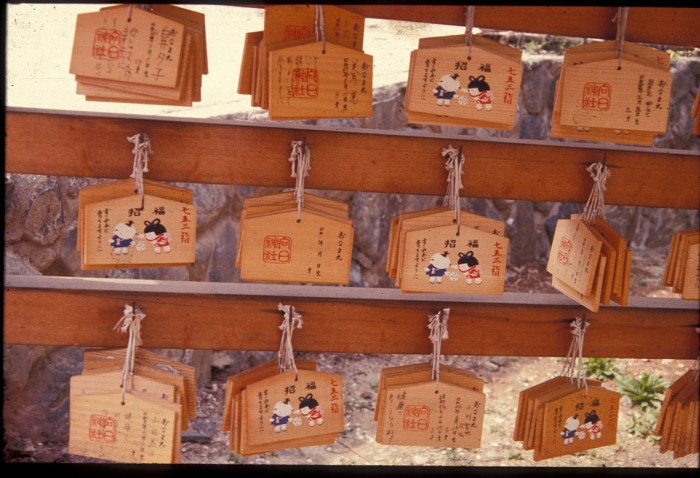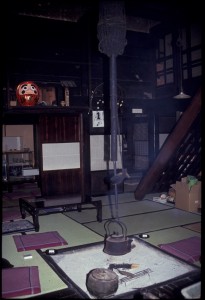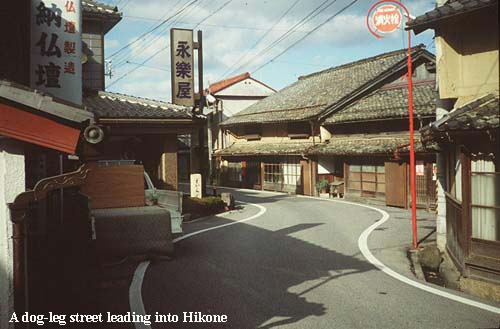
Every Buddhist temple and Shinto shrine offers a variety of prayer tablets, amulets and talismans to worshippers for protection in a wide variety of endeavors ranging from traffic safety to success in examinations to success in business. While some of these are purchased to put in a specific place (to attach to a briefcase or school bag or to hang from the rearview mirror of a car) some are more specifically for use in the home or shop.

Daruma
One of the more common ones is the daruma which is typical of eastern Japan with production centered in Takasaki and Gunma prefecture. Daruma is the Japanese name for the Indian priest Bodhidharma who was the founder of Zen Buddhism in China. This priest supposedly sat in meditation for nine years, so long that his arms and legs fell away, leaving him like the daruma figurines able to right himself if pushed over. Like the manekineko and butsudan described below, daruma achieved great popularity during the Edo period. Daruma supposedly provided protection against smallpox. Daruma are talismans which bring good fortune in a specific endeavor. At the beginning of the undertaking, a daruma is purchased and one eye is painted in; the remaining eye is painted when success is achieved. Daruma are frequently placed in the kamidana, the Shinto alter in the home.

Kamidana
Another talisman which the traveler sees frequently is the ‘beckoning cat’ or manekineko which is a pottery or paper-mache cat that gets its name by raising one forepaw and beckoning by curling the paw downwards. In Japanese body language, one summons people by turning the palm down and gesturing ‘come’ with the fingers. If the palm is turned up and the fingers are used to gesture, then one is beckoning an animal. The cat’s gesture is one which invites good fortune or customers to come in. Thus, it is very commonly found in retail shops, restaurants, and bars. Because of its association with good fortune, the manekineko are also popular as ‘piggy’ banks.
Tanuki are badgers or, more exactly, raccoon dogs. Pottery statues are common in gardens as well as restaurants and bars. Badgers are crafty, but are well liked, unlike the fox which has the power to change shapes and to bewitch humans. Tanuki repay kindness and, therefore, often appear as good figures in stories, folk tales and children’s yarns. As benefactors of bars, badgers are usually portrayed with large sake bottles and usually manage to look both canny and bemused with drink.
On the more serious side, many homes have a kamidana and a butsudan. A kamidana is a Shinto shrine, or ‘god’s shelf’, inside the home, and may be in the entry way or in the kitchen. It may contain representations of a local god, one of the main gods of Shinto like those from the Ise Shrines, or one or more of the seven gods of good fortune (some of these gods are Buddhist in origin, so it is usually only the Shinto ones which appear in the kamidana). Special ‘god’s shelves’ are built at certain times of the year, especially in the summer during the Bon Festival when ancestral spirits return to the home for three days. Offerings of sake, rice, and other food are made. The kamidana is generally made of plain, unfinished wood and often has features resembling a Shinto shrine.
A butsudan (‘Buddha shelf’) is a cabinet, frequently of ornately finished and lacquered wood, with an image of the Buddha and memorial tablets of ancestors, plus various accessories required for worship. The main function of the butsudan is ancestor worship. Both ancestor worship and maintaining a butsudan, essentially a small temple, in the house became popular during the Edo period when every family was required to register its membership with a Buddhist temple, partly to prove disbelief in Christianity. Offerings similar to those at the kamidana are made to the ancestors and to Buddha at the butsudan. The approach to Hikone castle town is lined with shops specializing in the craft production of butsudan which are well-known throughout Japan.


